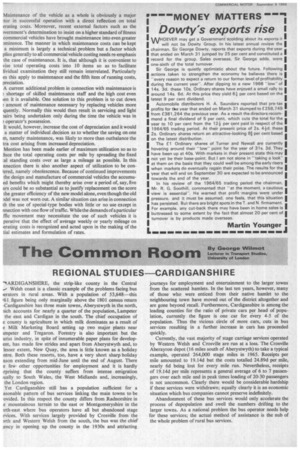REGIONAL STUDIES-CARDIGANSHIRE
Page 86

If you've noticed an error in this article please click here to report it so we can fix it.
"ARDIGANSHIRE, the strip-like county in the Central
Welsh coast is a classic example of the problems facing bus lerators in rural areas. With a population of 53,648—this 161 figure being only marginally above the 1801 census return -Cardiganshire has three main towns, Aberystwyth in the north, lich accounts for nearly a quarter of the population, Lampeter the east and Cardigan in the south. The chief occupation of
e county is agriculture in which milk dominates as a result of
e Milk Marketing Board setting up two major plants near unpeter and Tregaron. Forestry is also important but the urist industry, in spite of innumerable paper plans for developeat, has made few strides and apart from Aberystwyth and, to lesser extent, New Quay, the area is little known as a holiday ntre. Both these resorts, too, have a very short sharp holiday ason extending from mid-lime until the end of August. There
e few other opportunities for employment and it is hardly Lrprising that the county suffers from intense emigration .ually to South Wales, the West Midlands and, increasingly, the London region.
Yet Cardiganshire still has a population sufficient for a asonable pattern of bus services linking the main towns to be .ovided. In this respect the county differs from Radnorshire in e mountainous terrain to the east or Montgomeryshire in the nth-east where bus operators have all but abandoned stage rvices. With services largely provided by Crosville from the >rth and Western Welsh from the south., the bus was the chief ;ency in opening up the county in the 1930s and attracting journeys for employment and entertainment to the larger towns from the scattered hamlets. In the last ten years, however, many of those who were enticed from their native hamlet to the neighbouring town have moved out of the district altogether and are gone beyond recall. Furthermore, Cardiganshire is among the leading counties for the ratio of private cars per head of population, currently the figure is one car for every 4-5 of the population. Thus the vicious circle of more cars, cuts in bus services resulting in a further increase in cars has proceeded quickly.
Currently, the vast majority of stage carriage services operated by Western Welsh and Crosville are run at a loss. The Crosville Aberayron depot (16 miles south of Aberystwyth) to take a typical example, operated 264,000 stage miles in 1965. Receipts per mile amounted to 19.14d but the costs totalled 24.89d per mile, nearly 6d being lost for every mile run. Nevertheless, receipts, of 19.14d per mile represents a general average of 6 to 7 passengers over each mile and in peak times loading of 20-30 passengers is not uncommon. Clearly there would be considerable hardship if these services were withdrawn; equally clearly it is an economic situation which bus companies cannot preserve indefinitely.
Abandonment of these bus services would only accelerate the process of depopulation and swell the numbers drifting to the larger towns. As a national problem the bus operator needs help for these services; the actual method of assistance is the nub of the whole problem of rural bus services.
































































































































